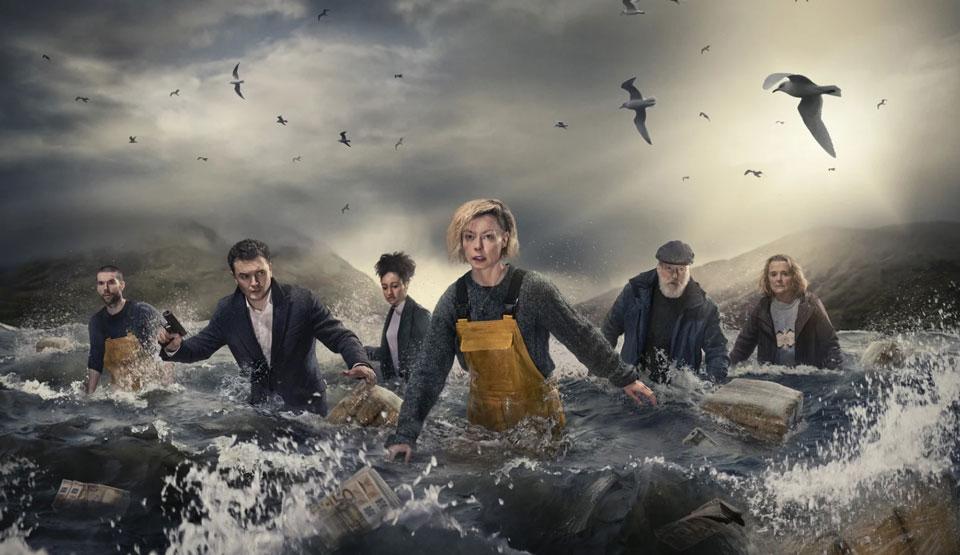
Looking at North Sea Connection, Savage River, After the Verdict, True Colours
Corporate streaming TV seems to be engulfed in a never-ending chasing of its own tail as its programming attempts to more frantically flee any form of social reality, even as that reality becomes more desperate for those working- and middle-class viewers living it. Digital companies use the programming to simply present the virtual world as an ever-expanding source of the abundance so sorely lacking in the actual lives of workers.
Take Amazon’s The Peripheral, part working-class Southern rural woman’s struggle, à la Jennifer Lawrence in Winter’s Bone, but the larger part, and the inducement for the series, is that same woman roaming freely through time and space in her online gaming life à la Westworld, or the much better, because also critical of that dichotomy, Ready Player One.
The Peripheral is by the creators of Westworld, and much like the often unwieldy attempts of characters to navigate the “multiverse” in Phase 4 of the Marvel Universe, amounts to a big-budget inane leaping from world to world in a failed attempt to leave this one behind. Facebook, now Meta’s, own attempt to foster this interior flight from reality—whose exterior equivalent is Elon Musk’s Space X which asserts that a lucky few will start over on Mars when earth is destroyed—is failing. Meta’s projected membership of 500,000 is instead less than 200,000 with company stock falling 62% as for many the $1500 headgear is too high a price for a trip to fantasy land.
This fall has featured huge investments in streaming production values as the competition between these megacorporations accelerates. The largest among them are using their financial heft to not only beat their close competitors but also to drive other streamers, unable to match the expensive “look” of these productions, out of the business. Thus, HBO’s Throne of the Dragon costs $20 million per episode and $200 million for the season, doubling the cost of its predecessor Game of Thrones. Amazon’s Rings of Power goes its competitor one better at $715 million for Season 1 and $90 million per episode.
The silver lining in this race to oblivion is that around the world, both private and public channels, which cannot match the budgets of these series, are, perhaps even by default, forced to produce series which deal with the actual breakdown of the global system as it affects the lives of its working- and middle-class protagonists. The best of the current crop of these series are Irish public television’s North Sea Connection, available on Viaplay, and, from Australia, the current leader in Social Realist TV, Australian public television’s Savage River and Significant Others on Paramount+, Australian Commercial TV’s After the Verdict on Apple TV+, and the Australian Indigenous Network’s True Colours, streaming on the Sundance Channel.
The average cost of a single episode on Australian TV is $760,000, so in a sense, outflanked in the ability to create alternate fantasy worlds, unable to match Amazon’s $90 million and HBO Max’s $20 million, these smaller entities are “forced” to take into account the actual problems facing their lead characters. This is similar in the Hollywood studio era—as everything new is old again—to RKO, the least wealthy of the Big 5 monopoly studios, embracing the film noirs of the 1940s in such films as Crossfire, whose subject was anti-Semitism, with the “value added” being the social content of the screenplays, rather than lavish production numbers.
North Sea Connection centers on a family fishing business. The oldest daughter Kiera is following in her dead father’s footsteps as the captain of a small fishing trawler. Her brother Aiden who tells her she cannot any longer make a living as an honest fisher—“Those days are gone and you know it”—instead, in language and flashy appearance that mark him as a representative of the “anything goes” neoliberal order, strikes a bargain with a methamphetamine dealer to begin bringing that drug into an Ireland that before, as the local cop says, “doesn’t have a meth problem.” Aiden sucks Kiera into his scheme, explaining his use of his fishing processing plant as a dumping ground for drugs as “a business transaction that benefits both of the parties.” He later excuses the death of one of the dealer’s henchmen on Kiera’s boat as a “work accident.” Aiden’s moneymaking frenzy also involves another type of addiction as he gambles on the horses and is late to meet his wife for an adoption interview. Elsewhere, Kiera’s mother (Sinéad Cusack), married to a Swede, discovers a criminal past that enabled them to buy their house and indicates that, for those living off the land to survive, the only path, in a globalized world organized against them, is the illegal one, a similar theme as that raised in last year’s Irish production A Clean Break. A viewer’s post accompanying the show accuses it of wasting national acting treasure Cusack’s talent in a middling production. The post itself is perhaps the result of the mega-streamer’s creation of the expectation of financial onscreen bombast replacing a more human scale in a series that puts front and center its critique of the inhuman values that themselves may emanate from these outsized productions.

The trope of the convicted criminal completing their sentence and returning to an unforgiving town has already produced two remarkable series in Sundance’s Rectify and Daisy Haggard’s Back to Life, and here in the Australian Broadcasting Company’s Savage River it produces a third. Miki (13 Reasons Why’s Katherine Langford which this series will turn into a megastar) has supposedly killed her best friend and returns after a five-year jail sentence to a small town where all activity is centered around a sheep slaughterhouse and meatpacking plant. Miki quickly finds herself in the midst of another murder she is blamed for, and in the later part of the series (episodes 5 and 6 of 6) she transforms from victim to active detective hunting the actual murderer. The slimy owner of the meat works wants to sell the plant to a global enterprise which he knows will mean job cuts. But when the town reacts, the corporation pulls out because, though they will clearly hollow out the enterprise, “our brand is community engagement not community warfare.”
The female mayoral candidate is opposed by the longstanding mayor who drips corruption from every pore and is in league with the meat works owner in putting across the sale. The female candidate proposes instead that the workers buy the plant, which the owner scoffs at claiming he could get “4 million” from the corporate buyers and “these idiots don’t have 50 [dollars] between them.” On the personal level, Miki is courted by both the local high school teacher, the mayor’s son, who abandoned her when she went to jail and now comes back around, and an Indigenous fellow worker who offers her affection and friendship, someone, as part of her challenging the power structure, she warms to. Savage River is one of the year’s best series and extremely attuned to the challenges and potential opportunities through collective organization facing the town’s workers.

After the Verdict, as attuned to the fraying middle class as Savage River is to workers, uses a gimmick to introduce a murder mystery that is fairly apparent from the start but which is only the excuse for and not the subject of the series. Four ordinary jurors, all beset in various ways with their own problems, free Laura, a wealthy female suspect who they then suspect may have used her class position and ease with power as tools to convince them she is innocent. The jurors then meet “after the verdict” to investigate whether or not they have made the wrong decision and perhaps been bamboozled by the woman’s wealth and position.
Clara, a Chinese-Australian and mother of two, negotiating a divorce with a husband who centered the marriage around him, is also underpaid and overworked at her clerical job. Daniel, eminently bribable, is a high school teacher, à la Breaking Bad, who can’t make ends meet as he attempts to provide some kind of life for his teenage daughter. Ollie is a sleazy and, of course, seductive real estate agent who has problems with abandonment which have kept him alone and isolated. Finally, Margie, a butcher, is in a relationship with an on-call overnight nurse Trish who distrusts Margie’s ability to be honest. Flawed characters all, but the flaws of each also have everything to do with a middle-class under constant pressure to pretend that all is well as the weight of work pressure, debt and their own family history impinges on them. The relationships each forms—two unlikely romantic couples, but also a male friendship of Ollie with Daniel and a female one with Margie that Ollie claims is a first in his life—are the heart of this series. The hopeful interactions of the group, as well as the fact that each is menaced by the wealthy figure of Laura, turn this from a despairing Breaking Bad into a show about how fellow feeling enables budding class cooperation to bloom in a series about the enduring and endearing relationships among these set-upon characters. Final verdict: Less slick on the same subject as Ozark and in the end vastly more hopeful.

The trope of the cop coming home which fuels most Scandinavian crime series, or Scandi Noir, is employed in National Indigenous Television’s True Colours to follow an overweight, and we later find out, pregnant cop sent farther into Australia’s Northern Territories, the center of Aboriginal life, to discover what has happened to a young girl thrown from a car under mysterious circumstances. The series was co-produced by the makers of another Indigenous detective series Mystery Road. The casting is akin to that of the Australian series Significant Others, where various flawed and physically mundane family members come together in a run-down home. Likewise, the characters peopling True Colours are anything but Hollywood glamorous. Instead, the series opts for a gritty portrayal of various Indigenous retaining their lifestyle and customs as a way of confronting poverty.
The True Colours of the series are of two varieties. The first is the open racism of the society as in the opening urban sequence Toni, the plainclothes detective, is confronted by a convenience store clerk who calls her “a f***ing black” and whom Toni afterwards follows and tickets. The other meaning of true colors is the constant array of splendid Indigenous art as Toni, back home, visits a group of elderly female artists painting a mural that will be displayed in Pari—reminiscent of a recent exhibition in that city by Indigenous artist Sally Gabori—though their white broker, a sister in the tribe, will earn 60 percent of the profits.
Each of these series in its own way counters both the big budget “metaverses” of the corporate streamers and the flashy and insincere casting of series such as ABC’s Big Sky, a supposedly slice-of-life of Montana which instead is simply an array of beautiful, toned Hollywood types masquerading as ordinary. There is a huge gap between Ireland’s and Australia’s working-, middle- and Indigenous-class representations and Hollywood’s Montana Hunks.










